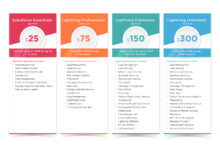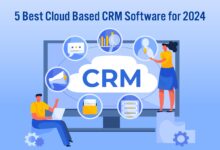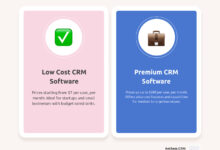Salesforce CRM Cost: Factors, Pricing Plans, and Hidden Fees
When it comes to Salesforce CRM cost, understanding the factors, pricing plans, and hidden fees can make all the difference in your decision-making process.
Delve into the details to uncover the true cost of implementing this powerful CRM solution.
Overview of Salesforce CRM Cost
When considering the cost of Salesforce CRM, several factors come into play. These include user licenses, storage requirements, and additional features that may be necessary for your business operations.
Different Pricing Plans
- Salesforce Essentials: Ideal for small businesses, starting at $25 per user per month.
- Sales Cloud: For sales teams, starting at $75 per user per month.
- Service Cloud: For customer service teams, starting at $75 per user per month.
- Marketing Cloud: For marketing teams, starting at $400 per month.
It’s important to note that these prices may vary based on the number of users and specific business needs. Additionally, there may be setup fees, customization costs, and integration expenses that can add to the overall cost of using Salesforce CRM.
Comparison of Salesforce CRM and HubSpot CRM
When comparing Salesforce CRM and HubSpot CRM, it’s essential to consider the key features and capabilities each platform offers. Salesforce CRM is known for its robust customization options and scalability, while HubSpot CRM is praised for its user-friendly interface and marketing automation tools.
In terms of pricing, Salesforce CRM tends to be more expensive than HubSpot CRM, especially for small businesses. However, Salesforce CRM may offer more advanced features and integrations, depending on your business requirements.
Implementing Salesforce CRM for Small Businesses
Setting up Salesforce CRM for a small business involves creating an account, customizing the platform to fit your needs, and training your team on how to use it effectively. To maximize the use of Salesforce CRM within budget constraints, small businesses can start with a basic plan and gradually add features as needed.
Using Salesforce CRM can benefit small businesses by improving efficiency, streamlining customer management processes, and providing growth opportunities through data analysis and targeted marketing strategies.
Salesforce CRM License Costs
When it comes to using Salesforce CRM, there are different types of licenses available, each with its own set of features and pricing. Understanding the differences between Standard, Professional, Enterprise, and Unlimited editions can help you choose the right option for your business needs and budget.
Types of Licenses
- Standard Edition: This basic license option offers essential CRM features at a lower cost, making it ideal for small businesses or startups.
- Professional Edition: With additional customization options and support levels, this license is suitable for growing businesses with more complex needs.
- Enterprise Edition: Designed for larger organizations, this license provides advanced features, including API access and more robust support.
- Unlimited Edition: The most comprehensive license option, offering all features and maximum customization capabilities for large enterprises with complex requirements.
Impact of User Count
The number of users you have can significantly impact the overall cost of Salesforce CRM licenses. Pricing tiers are typically based on the number of users, with discounts often available for larger user counts. It’s essential to consider your current user count and potential growth when selecting a license type.
Feature Comparison and Add-Ons
| License Type | Key Features | Pricing |
|---|---|---|
| Standard Edition | Basic CRM features | $$ |
| Professional Edition | Additional customization options, enhanced support | $$$ |
| Enterprise Edition | Advanced features, API access, premium support | $$$$ |
| Unlimited Edition | Maximum customization, all features included | $$$$$ |
When considering Salesforce CRM license costs, it’s essential to factor in add-on features such as marketing automation or analytics. These additional features can increase the total cost but may provide valuable functionality that aligns with your business objectives. Make sure to evaluate the benefits of these add-ons in relation to your budget and requirements before making a decision.
Implementation Costs of Salesforce CRM
Implementing Salesforce CRM involves various costs that organizations need to consider. These costs can vary based on the complexity of the organization’s needs and the extent of customization required. Here are some examples of implementation costs associated with Salesforce CRM:
Customization Costs
Customizing Salesforce CRM to align with specific business processes and requirements can incur additional costs. This includes configuring workflows, creating custom fields, and developing tailored solutions to meet the organization’s unique needs.
Data Migration Costs
Migrating data from existing systems to Salesforce CRM requires careful planning and execution. Data cleansing, mapping, and migration processes can add to the implementation costs, especially for organizations with large volumes of data or complex data structures.
Training Costs
Training employees on how to use Salesforce CRM effectively is essential for maximizing the benefits of the system. Investing in training programs, user guides, and ongoing support can contribute to the overall implementation costs of Salesforce CRM.
Integration Costs
Integrating Salesforce CRM with other systems and applications within the organization’s IT infrastructure can incur additional costs. This includes developing APIs, setting up data sync processes, and ensuring seamless communication between different platforms.
Consulting Costs
Engaging consultants or Salesforce implementation partners to assist with the deployment and customization of Salesforce CRM can add to the overall implementation costs. These professionals provide expertise and guidance to ensure a successful implementation process.
License Costs
In addition to the implementation costs, organizations need to consider the ongoing license costs associated with using Salesforce CRM. These costs can vary based on the number of users, the type of licenses required, and any additional features or functionalities needed.
Customization Costs for Salesforce CRM
Customizing Salesforce CRM to fit specific business requirements can incur additional costs that businesses need to consider. This customization allows companies to tailor the CRM system to their unique needs and processes, improving efficiency and user experience.
Cost Implications of Customization
Customization options in Salesforce CRM can range from simple modifications to complex integrations with other systems. These customization efforts often require expertise and resources, which can impact the overall cost of implementation.
- Examples of customization options and their associated costs:
- – Customized reports and dashboards: $1,000 – $5,000
- – Workflow automation: $500 – $2,500
- – Integration with third-party apps: $2,000 – $10,000
One-Time Expenses vs. Recurring Fees
Customization costs are typically one-time expenses, as businesses invest in tailoring the CRM system to their needs during implementation. However, ongoing maintenance and support for customizations may incur recurring fees, especially when updates or enhancements are required.
Evaluating ROI for Customization
Businesses should evaluate the return on investment (ROI) for customization efforts by considering the impact on productivity, efficiency, and revenue generation. Tracking key performance indicators (KPIs) before and after customization can help measure the success and benefits of the tailored CRM system.
External Consultants vs. In-House Resources
Hiring external consultants for customization can be more costly upfront but may provide specialized expertise and faster implementation. On the other hand, utilizing in-house resources can reduce immediate costs but may require additional training and longer implementation timelines.
Common Customization Features and Costs
| Customization Feature | Typical Cost | Impact on User Experience |
|---|---|---|
| Customized Reports and Dashboards | $1,000 – $5,000 | Enhanced data visualization and insights for users |
| Workflow Automation | $500 – $2,500 | Streamlined processes and increased efficiency |
| Integration with Third-Party Apps | $2,000 – $10,000 | Seamless connectivity with external tools and systems |
Scalability of Customized Solutions
Customized solutions in Salesforce CRM can be scalable, allowing businesses to adapt and grow with changing needs. However, scalability may require additional customization or enhancements over time, leading to potential long-term costs as the CRM system evolves.
Integration Costs with Salesforce CRM
When considering the implementation of Salesforce CRM, integration costs play a crucial role in the overall budget. Integrating Salesforce CRM with other applications or systems involves certain expenses that need to be accounted for.
Costs Involved in Integration
- Consultation fees for experts who will handle the integration process.
- Licensing fees for any third-party applications that need to be integrated.
- Custom development costs if specific integrations are required.
- Data migration expenses to ensure a smooth transition of data between systems.
Common Integrations and Cost Implications
- Integration with email marketing platforms such as MailChimp may incur additional subscription fees.
- Connecting Salesforce CRM with ERP systems like SAP could involve higher development costs due to the complexity of the integration.
- Integrating with social media platforms for customer engagement might require additional customization, leading to increased costs.
Consideration and Estimation of Integration Costs
It is essential to factor in integration costs from the beginning when budgeting for Salesforce CRM implementation. The complexity of the systems involved will influence the overall cost of integration. Estimating these costs requires a detailed analysis of the integration requirements and potential challenges.
Factors Influencing Integration Costs
- The number of systems being integrated with Salesforce CRM.
- The level of customization needed for seamless integration.
- Data volume and complexity of data migration processes.
- The expertise of the integration team and any additional training required.
Potential Cost Savings from Successful Integration
A successful integration with Salesforce CRM can lead to significant cost savings in the long run. Streamlining processes, improving data accuracy, and enhancing customer interactions are some of the benefits that can result from a well-executed integration. These savings justify the initial investment in integration costs.
Maintenance and Support Costs for Salesforce CRM
When utilizing Salesforce CRM, it is essential to consider the ongoing maintenance and support costs that come with it. These costs play a significant role in the overall expenditure associated with the platform.
Support Plans Offered by Salesforce and Their Costs
Salesforce offers various support plans tailored to meet the needs of different businesses. These plans provide access to technical assistance, training resources, and product enhancements. The costs of these support plans vary depending on the level of service and features included.
- Standard Support Plan: This plan typically includes basic support services and is priced at a standard rate.
- Premier Support Plan: For businesses requiring more advanced support and quicker response times, the Premier Support Plan is available at a higher cost.
- Signature Support Plan: This top-tier plan offers personalized support and dedicated resources for organizations with complex requirements, at a premium price.
Impact of Maintenance and Support Costs on Total Cost of Ownership
The maintenance and support costs for Salesforce CRM can significantly impact the total cost of ownership for businesses. While these costs ensure that the platform remains functional and up-to-date, they should be factored into the overall budgeting and financial planning.
Cost Savings and ROI of Salesforce CRM
Implementing Salesforce CRM can lead to significant cost savings for organizations by streamlining processes, improving efficiency, and enhancing productivity.
Improved Efficiency and Productivity
By centralizing customer data, automating tasks, and providing real-time insights, Salesforce CRM enables teams to work more efficiently and effectively.
- Increased collaboration among teams leads to faster decision-making and improved customer service.
- Automation of repetitive tasks reduces manual errors and frees up time for more strategic activities.
- Access to real-time data and analytics helps in identifying trends, optimizing marketing campaigns, and making informed business decisions.
Calculating Return on Investment
Measuring the return on investment of implementing Salesforce CRM involves analyzing the costs incurred against the benefits gained.
ROI = (Net Profit / Cost of Investment) x 100
- Identify all costs associated with implementing Salesforce CRM, including license fees, customization, training, and maintenance.
- Evaluate the benefits such as increased sales, improved customer retention, reduced operational costs, and time savings.
- Calculate the net profit by subtracting the total costs from the total benefits.
- Divide the net profit by the cost of investment and multiply by 100 to get the ROI percentage.
Factors Influencing the Total Cost of Salesforce CRM
When it comes to determining the total cost of using Salesforce CRM, there are several key factors that can influence the pricing. These factors can vary depending on the size of the business, the industry it operates in, the level of customization needed, and other specific requirements. Understanding these factors is crucial for organizations to optimize their Salesforce CRM costs effectively.
Business Size
- The size of the business plays a significant role in determining the cost of Salesforce CRM. Small businesses may opt for basic features and functionalities, while large enterprises might require more advanced solutions, resulting in higher costs.
- Licensing fees and user subscriptions are often based on the number of users, so the size of the organization directly impacts the overall cost.
- Smaller businesses may benefit from scaled-down versions of Salesforce CRM that offer essential features at a lower price point.
Industry
- Industry-specific requirements can also impact the total cost of Salesforce CRM. Certain industries may require specialized features or compliance standards, leading to additional customization and integration costs.
- For example, healthcare organizations may need to adhere to strict security and privacy regulations, resulting in tailored solutions that come at a higher price.
- Understanding industry-specific needs and regulations is essential for accurate cost estimation and budget planning.
Customization Needs
- The level of customization needed in Salesforce CRM can significantly influence the total cost. Custom development, integration with existing systems, and personalized workflows can add to the overall expenses.
- Organizations with unique business processes or specific requirements may incur higher costs for customization to align Salesforce CRM with their operations effectively.
- Balancing customization needs with budget constraints is essential to optimize costs without compromising on functionality.
Other Factors
- Additional factors such as data migration, training, ongoing support, and system maintenance can also impact the total cost of Salesforce CRM implementation.
- Choosing the right implementation partner, negotiating contracts, and regularly reviewing usage and needs can help organizations optimize costs and maximize ROI.
Cost Comparison with Other CRM Solutions
When considering a CRM solution for your business, it’s essential to compare the costs of different options in the market. In this section, we will compare the cost of Salesforce CRM with other popular CRM solutions, highlighting the pricing, features, and overall value provided by each platform.
Pricing Plans Comparison
Let’s take a look at the pricing plans of Salesforce CRM and some of its competitors to understand the cost differences:
| CRM Solution | Pricing | Additional Fees |
|---|---|---|
| Salesforce CRM | Starting at $25/user/month | No hidden costs |
| Competitor A | Starting at $30/user/month | Additional fees for advanced features |
| Competitor B | Starting at $20/user/month | Hidden costs for customization |
Key Features Analysis
Now, let’s break down the key features offered by Salesforce CRM and its competitors to analyze the value proposition:
- Salesforce CRM: Advanced customization options, robust reporting tools, seamless integration with third-party apps.
- Competitor A: User-friendly interface, strong customer support, limited customization capabilities.
- Competitor B: Affordable pricing, basic features, lack of scalability.
Customer Satisfaction Levels
Customer reviews and satisfaction levels play a crucial role in determining the cost-effectiveness of a CRM solution. Here’s what users have to say:
“Salesforce CRM offers great value for the price, with its extensive features and scalability.” – John, Sales Manager
“Competitor A may be slightly more expensive, but the customer support is top-notch, making it worth the investment.” – Sarah, Marketing Director
Negotiating Salesforce CRM Costs
When it comes to negotiating Salesforce CRM costs, there are several strategies that can help you secure better pricing and maximize your budget. Understanding how to leverage discounts, promotions, and special offers from Salesforce is crucial in getting the best deal possible. It’s also important to carefully review and analyze contract terms and conditions to ensure you are getting the most value for your investment. By evaluating your CRM needs and identifying potential cost-saving opportunities, you can tailor your negotiation approach to align with your business objectives. Building a strong relationship with your Salesforce account manager can also be key in negotiating costs effectively. Additionally, knowing when to scale up or down your CRM services based on cost considerations is essential for optimizing your CRM investment.
Strategies for Negotiating Better Pricing
- Research and compare pricing plans offered by Salesforce to understand the range of options available.
- Highlight your long-term commitment and potential for expansion to negotiate discounted rates.
- Consider bundling services or features to negotiate a better overall package deal.
- Request a detailed breakdown of costs and services to identify areas where you can negotiate for better terms.
- Engage in open communication with your Salesforce account manager to express your budget constraints and explore flexible pricing options.
Hidden Costs to Consider with Salesforce CRM
When implementing Salesforce CRM, it is crucial to be aware of potential hidden costs that may arise throughout the process. These costs can impact the overall budget and should be carefully considered to avoid any surprises down the line.
Uncovering Hidden Costs
- One of the ways to uncover hidden costs with Salesforce CRM is to conduct a thorough analysis of all the features and functionalities needed for your specific business requirements.
- Engaging with experienced consultants or experts in Salesforce implementation can also help identify any potential hidden costs that may not be immediately apparent.
Examples of Hidden Costs
-
Customization Expenses:
Customizing Salesforce CRM to align with your business processes may incur additional costs for development and integration.
-
Data Migration Costs:
Moving existing data from legacy systems to Salesforce CRM can involve fees for data cleansing, mapping, and migration processes.
Thorough Cost Analysis
Before implementing Salesforce CRM, it is essential to conduct a comprehensive cost analysis that includes not only the upfront expenses but also the potential hidden costs that may arise during and after implementation.
Estimating Ongoing Maintenance Expenses
- Regular maintenance and updates for Salesforce CRM can lead to ongoing expenses that should be factored into the total cost of ownership.
- Estimating the frequency of updates, support costs, and training expenses can help in determining the long-term maintenance budget.
Impact of Customization and Integration
- Customizing Salesforce CRM to meet specific business needs and integrating it with other systems can significantly impact the total cost of ownership.
- Each customization or integration may require additional resources, time, and costs, which should be considered in the overall budget.
Cost Management Strategies for Salesforce CRM
Effective cost management is crucial when it comes to implementing Salesforce CRM. By implementing the right strategies, businesses can optimize spending while maximizing the benefits of the platform. Here are some best practices for managing and controlling costs associated with Salesforce CRM:
Regularly Review and Optimize Licenses
- Regularly review the number of user licenses needed and adjust accordingly based on actual usage.
- Consider the different types of licenses available and choose the most cost-effective options for your team.
- Optimize license usage by providing training and support to ensure users are utilizing the platform efficiently.
Monitor and Analyze Usage Data
- Track and monitor user activity to identify any underutilized features or areas where training may be needed.
- Analyze usage data to understand which features are most valuable to your team and focus on optimizing those areas.
- Use analytics tools provided by Salesforce to gain insights into user behavior and trends, allowing for targeted cost-saving measures.
Implement Cost-Saving Automation
- Automate repetitive tasks and workflows to increase efficiency and reduce manual labor costs.
- Utilize Salesforce automation tools like Process Builder and Workflow Rules to streamline processes and save time and resources.
- Regularly review and optimize automated processes to ensure they are still aligned with business goals and objectives.
Cost Estimation Tools for Salesforce CRM
When it comes to estimating the cost of implementing Salesforce CRM, organizations can leverage various tools and resources designed specifically for this purpose. These tools can provide valuable insights and assist in planning and budgeting effectively.
Features and Benefits of Cost Estimation Tools
- Cost estimation tools offer a structured approach to forecasting expenses related to Salesforce CRM implementation.
- They help in analyzing different pricing models and customization options to determine the most cost-effective solution.
- These tools provide a comprehensive view of the total cost of ownership, including licensing, implementation, customization, integration, and ongoing support costs.
- By using cost estimation tools, organizations can make informed decisions and align their budget with the expected expenses.
Guidance on Effective Use of Cost Estimation Tools
- Ensure accurate data input by gathering information on user requirements, functionalities needed, and expected usage.
- Regularly update cost estimation tools with the latest pricing information from Salesforce and third-party vendors.
- Collaborate with different stakeholders to validate cost estimates and adjust them based on changing business needs.
- Use scenario analysis to explore various cost implications and optimize the budget for Salesforce CRM implementation.
Importance of Considering Pricing Models and Customization Options
When estimating costs for Salesforce CRM, it is essential to evaluate different pricing models such as per-user pricing, feature-based pricing, or tiered pricing. Customization options like add-on functionalities, third-party integrations, and data migration services should also be factored in for a comprehensive cost estimate.
Process of Data Input for Accurate Cost Estimation
For accurate cost estimation using tools, organizations need to input data related to the number of users, desired features, implementation timeline, integration requirements, training needs, and ongoing maintenance plans. The more detailed and specific the data input, the more precise the cost estimate will be.
Examples of Cost Estimation Tool Scenarios
Cost estimation tools can help organizations in scenarios such as determining the ROI of Salesforce CRM, comparing costs with other CRM solutions, evaluating the impact of customization on expenses, and forecasting the total cost of ownership over a specified period. These tools empower decision-makers to make data-driven choices and optimize their Salesforce CRM investment.
Tips for Budgeting for Salesforce CRM Costs
When it comes to budgeting for Salesforce CRM costs, it is crucial to have a thorough understanding of all expenses involved in implementation and maintenance. By creating a comprehensive budget, you can ensure that you are prepared for all financial aspects related to Salesforce CRM.
Importance of Setting Aside a Contingency Fund
It is essential to set aside a contingency fund for unforeseen expenses that may arise during Salesforce CRM implementation. Unexpected costs can occur, such as additional customization requirements or integration complexities. Having a contingency fund can help mitigate any financial surprises and ensure a smooth implementation process.
Step-by-Step Guide to Creating a Comprehensive Budget
Creating a budget for Salesforce CRM involves several steps to accurately account for all costs. Here is a step-by-step guide to help you create a comprehensive budget:
- Identify all direct costs associated with Salesforce CRM, such as license fees, implementation costs, customization expenses, integration fees, and maintenance and support charges.
- Consider indirect costs, including training expenses, downtime during implementation, and potential productivity loss during the learning curve.
- Factor in any hidden costs that may not be immediately apparent, such as data migration fees, additional user licenses, or third-party software requirements.
- Allocate resources for ongoing maintenance and support to ensure the CRM system remains operational and up-to-date.
- Review your budget regularly and make adjustments as needed to accommodate any changes in requirements or costs.
Cost-Effective Alternatives to Reduce Salesforce CRM Costs
In today’s business landscape, finding ways to reduce costs without compromising efficiency is crucial. When it comes to Salesforce CRM, there are several cost-effective alternatives that organizations can explore to lower their overall expenses while still benefiting from the platform’s features and functionalities.
One of the key strategies to reduce Salesforce CRM costs is by optimizing the usage and scaling the platform according to the organization’s needs. By regularly reviewing user licenses and access levels, companies can ensure they are not paying for unnecessary features or seats. This can help in avoiding over-licensing and optimizing the investment in Salesforce CRM.
Scaling Usage and Optimizing Workflows
- Regularly review and adjust user licenses and access levels to match actual needs.
- Implement automated workflows to streamline processes and reduce manual efforts.
- Leverage Salesforce’s reporting and analytics tools to identify areas for optimization.
- Train employees on best practices to maximize efficiency and minimize errors.
Another cost-effective alternative to consider is leveraging free Salesforce tools and features that can enhance the CRM experience without additional costs. Salesforce offers a range of free resources, such as Trailhead for training, AppExchange for free or low-cost apps, and community forums for support and guidance. By utilizing these resources effectively, organizations can reduce their reliance on expensive customizations or third-party solutions.
Leveraging Free Salesforce Tools
- Explore Trailhead for free training and skill development for employees.
- Utilize the Salesforce AppExchange for free or low-cost apps to enhance CRM functionalities.
- Engage with the Salesforce community for support, best practices, and networking opportunities.
- Regularly review and update Salesforce configurations to take advantage of new features and updates.
By implementing these cost-effective alternatives, organizations can effectively reduce their Salesforce CRM costs while still maintaining a high level of performance and quality. It’s essential to continuously monitor and optimize usage, leverage free resources, and stay informed about new developments to ensure maximum cost savings and ROI from Salesforce CRM.
Conclusion
Explore the realm of Salesforce CRM cost and take charge of your budget with newfound knowledge and insights gained from this discussion.




